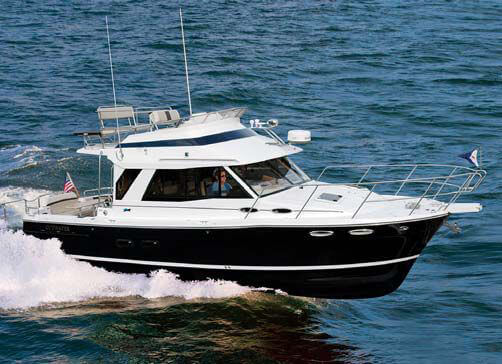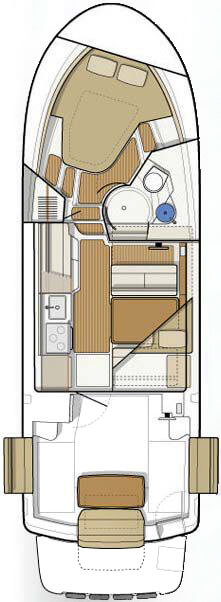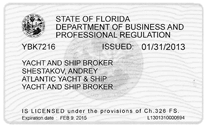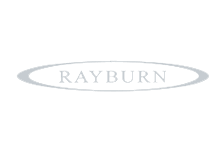Cutwater 30 Command Bridge Yacht Review
Posted 2015/09/21 at 22:33 in Yacht Reviews
 The 30 Command Bridge is the third generation of the C30 Cutwater with a few more features than her two sister lines. Her rich designing allows for two staterooms along with a head with a separate shower stall. The CB30 has a retractable flying bridge cowling and dashboard that when folded down allows this vessel to be wholly trailable. This increases her cruising potential with cross-country and over the road possibilities.
The 30 Command Bridge is the third generation of the C30 Cutwater with a few more features than her two sister lines. Her rich designing allows for two staterooms along with a head with a separate shower stall. The CB30 has a retractable flying bridge cowling and dashboard that when folded down allows this vessel to be wholly trailable. This increases her cruising potential with cross-country and over the road possibilities.

LOA: 34’4″
BEAM: 10’0″
DRAFT: 2’5″
DISPL.: 10,980 lb.
FUEL: 180 gal.
WATER: 80 gal.
TEST POWER: 1/370-hp Volvo Penta D6 diesels
OPTIONAL POWER: 1/430-hp Volvo Penta D6 diesels
TRANSMISSIONS: Volvo with 1.97:1 gear ratio
PROPELLERS: 20×22, 4-blade
GENERATOR (OPTIONAL): 5-kW Onan
BASE PRICE: $299,937
| RPM | KNOTS | GPH | RANGE | dB(A) |
|---|---|---|---|---|
| 600 | 3.6 | 0.3 | 1944 | 64 |
| 1000 | 5.6 | 0.9 | 1088 | 66 |
| 1500 | 7.5 | 2.3 | 528 | 71 |
| 2000 | 8.7 | 5.3 | 266 | 72 |
| 2500 | 12.4 | 8.9 | 226 | 74 |
| 3000 | 17.5 | 13.0 | 218 | 76 |
| 3500 | 22.8 | 19.0 | 194 | 78 |
| 3600 | 24.4 | 21.0 | 188 | 79 |
Accommodations
The flying bridge deck accommodates up to four people by offering a spacious main deck layout and is accessed easily through a set of stairs with handrails. Forward is a master stateroom that provides a double berth, hanging locker, five port-lights and an opening overhead hatch. There is an impressive adjoining head, that is not only practical but convenient, with two opening ports, molded fiberglass vanity and an electric MSD.
Farther aft is a starboard helm station with a custom wood wheel and binnacle type electronic engine control. On the opposite side is a built-in companion lounge which can be reversed, for social purposes, to face aft.
The Cutwater 30 touts very large windshield panels and side windows, allowing the interior to remain brighter and facilitates navigational commands from the lower helm.
A saloon and galley occupies the rear of the main deck and runs along the port-side to starboard with a raised dinette that seats four. The galley offers an electric cook-top, oven and microwave oven, wine cooler, stainless steel sink and under the counter refrigerator.
The dinette has a pedestal cherry table that converts to a double berth. This area also offers another berthing area by lifting a hatch-like section of the dinette’s deck, allowing access to a amidships cabin with a double berth and gear stowage area. The cabin is furnished with port-lights and reading lamps and is quite comfortable once you are inside.
Construction
The CB30’s hull is laid up in an open mold while the stringer grid and two part liner are laid up somewhere else. When all three parts are finished, the stringer grid is secured in the hull while still in the mold. The liners are also secured along with the plumbing, electronics and other system components.
The deck is created via a very complex tooling so it is fully cured when hull/stringer, grid/liner is removed from their molds. It is secured to the hull using stainless steel bolts and 3M polyurethane adhesive. This is a very strong and very efficient way to erect an all fiberglass boat because the majority of the work is being done outside the boat.
Performance
On flat water, not far from Muilteo, Washington (in Possession Sound), the CB30 turned in a two way average top speed of 24.4 knots. This somewhat improved when Cutwater decided to offer a larger engine, the 430 horsepower Volve Penta D6. At the lower end of that scale is the smaller 370 horsepower diesel, that is cost efficient, burning 2.3 gallons per hour and achieving approximately 7.5 knots.
There is excellent visibility from the helm stations, upper and lower because of the prop walk inherent in a single engine power plant going hard-over to port at wide open throttle. A comparatively wide turn doing the same maneuver to starboard cut the tactical diameter to approx. three boat lengths from five boat lengths. Maneuvering dockside, one forward and one aft, was easy.














